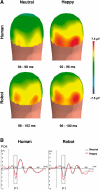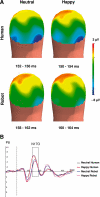Human brain spots emotion in non humanoid robots
- PMID: 20194513
- PMCID: PMC3023084
- DOI: 10.1093/scan/nsq019
Human brain spots emotion in non humanoid robots
Abstract
The computation by which our brain elaborates fast responses to emotional expressions is currently an active field of brain studies. Previous studies have focused on stimuli taken from everyday life. Here, we investigated event-related potentials in response to happy vs neutral stimuli of human and non-humanoid robots. At the behavioural level, emotion shortened reaction times similarly for robotic and human stimuli. Early P1 wave was enhanced in response to happy compared to neutral expressions for robotic as well as for human stimuli, suggesting that emotion from robots is encoded as early as human emotion expression. Congruent with their lower faceness properties compared to human stimuli, robots elicited a later and lower N170 component than human stimuli. These findings challenge the claim that robots need to present an anthropomorphic aspect to interact with humans. Taken together, such results suggest that the early brain processing of emotional expressions is not bounded to human-like arrangements embodying emotion.
Figures




References
-
- Adolphs R. Recognizing Emotion from Facial Expressions: Psychological and Neurological Mechanisms. Behavioral and Cognitive Neuroscience Reviews. 2002;1:21–62. - PubMed
-
- Adolphs R. Emotional vision. Nature Neuroscience. 2004;7:1167–8. - PubMed
-
- Allison T, Puce A, McCarthy G. Social perception from visual cues: role of the STS region. Trends In Cognitive Sciences. 2000;4:267–78. - PubMed
-
- Alorda C, Serrano-Pedraza I, Campos-Bueno JJ, Sierra-Vazquez V, Montoya P. Low spatial frequency filtering modulates early brain processing of affective complex pictures. Neuropsychologia. 2007;45:3223–33. - PubMed
-
- Amaral DG, Behniea H, Kelly JL. Topographic organization of projections from the amygdala to the visual cortex in the macaque monkey. Neuroscience. 2003;118:1099–120. - PubMed

